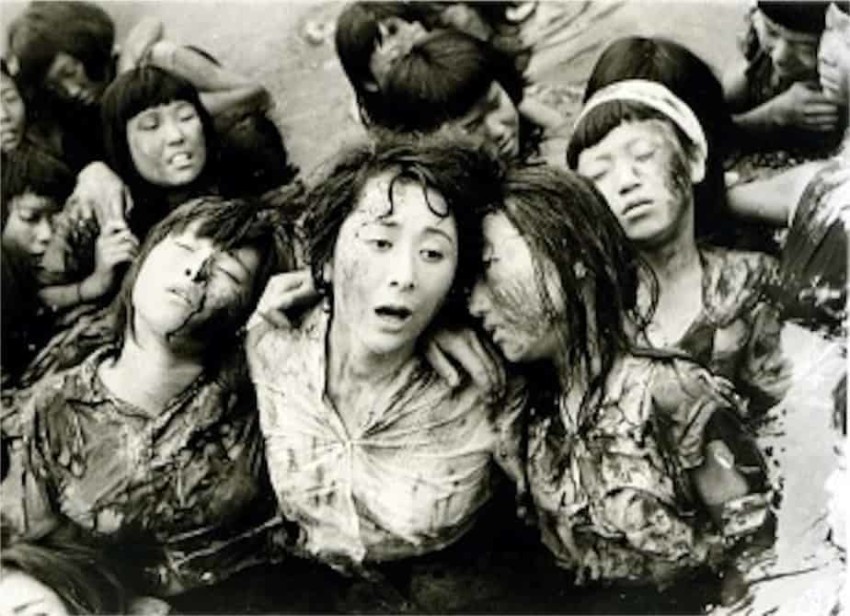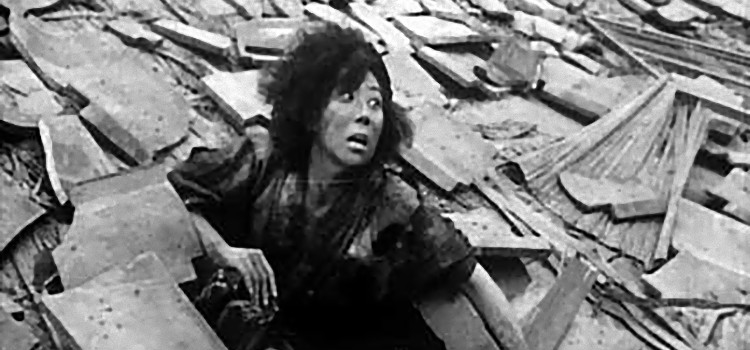Hiroshima
August 5, 2020 · 1 comment
By Jonathan Clements.
 After his classroom is disrupted by a girl with a nosebleed, Mr Kitagawa (Eiji Okada) comes to understand that many of the people in Hiroshima are still suffering the after-effects of the city’s atomic bombing seven years earlier. Although parts of the city have returned to relative calm, with volley-ball matches under a blue sky and bustling shopping arcades, other areas are still in ruins and families are struggling with life-threatening radiation burns and poisoning. The atomic bombing of 6th August 1945 is a shadow that hangs over every aspect of 1950s Japan, a secret scandal borne not only by the students in Mr Kitagawa’s class, but by his fellow teachers, some of whom have harrowing stories to tell about their experiences.
After his classroom is disrupted by a girl with a nosebleed, Mr Kitagawa (Eiji Okada) comes to understand that many of the people in Hiroshima are still suffering the after-effects of the city’s atomic bombing seven years earlier. Although parts of the city have returned to relative calm, with volley-ball matches under a blue sky and bustling shopping arcades, other areas are still in ruins and families are struggling with life-threatening radiation burns and poisoning. The atomic bombing of 6th August 1945 is a shadow that hangs over every aspect of 1950s Japan, a secret scandal borne not only by the students in Mr Kitagawa’s class, but by his fellow teachers, some of whom have harrowing stories to tell about their experiences.
Hideo Sekigawa’s Hiroshima (1953) uses the tense normalcy of everyday life as a framing device to retell the story of the city’s bombing, not merely the explosion and immediate aftermath, but the stunned reaction of the Japanese authorities to the utmost devastation of a “new type of bomb.” It is plainly intended as a didactic experience, focussing in particular on the young victims of the attack – even its title is written in easy-to-read hiragana, evoking a childish incomprehension of the forces at work elsewhere. To truly appreciate it, however, one needs to understand the politicking and arguments around its release – refused exhibition by many 1950s cinemas, it was buried at the box office, ostensibly for its unwelcome engagement with issues that Cold War Japan was still trying to suppress.
In other words, this is a film that would die without decent extras. Fortunately, as with Arrow’s recent Merry Christmas Mr Lawrence Blu-ray, the extras package is exemplary, transforming this presentation from a preachy, worthy independent film with a few shonky amateur performances into a snapshot of a moment in Japanese movie history. As well as Sekigawa’s film, the disc comes with the feature-length documentary Hiroshima Nagasaki Download (2011), and an archive interview with the film’s leading lady, Yumeji Tsukioka. A 30-minute video essay by Jasper Sharp chronicles the available archive of documentary footage, as well as Arata Osada’s 1951 book Children of the A-Bomb, on which it was ostensibly based. His siting of the film in Japanese cinema history goes on not only to discuss the subsequent works of Sekigawa’s career, but later films touching on the atomic bomb, including Masaki Mori’s landmark anime Barefoot Gen (although not the manga that inspired it) and Sayoko and Renzo Kinoshita’s art-house animated short Pikadon (1979).
 The accompanying booklet includes two exhaustive essays by Mick Broderick and Sharp (again), placing the film in its historical context as the second of two Hiroshima movies made at the instigation of the Japan Teachers’ Union. The first, by Kaneto Shindo, hadn’t hit the note required by the JTU, leading the organisation to draft Sekigawa in to make his own version. If, at times, Hiroshima feels like it is arguing with an off-screen shadow, that is because it is – Shindo’s Children of Hiroshima (1952) was widely praised by critics and popular with audiences, but irritated the hell out of the JTU by treating the material as a personal, Inland-Sea teacher’s memoir, foreshadowing the equally crowd-pleasing 24 Eyes (1954). The JTU wanted its Hiroshima movie to be a hard-hitting piece of educational agit-prop, leading Sekigawa’s run at the same material from an altogether different direction. This was declared to be more suitable.
The accompanying booklet includes two exhaustive essays by Mick Broderick and Sharp (again), placing the film in its historical context as the second of two Hiroshima movies made at the instigation of the Japan Teachers’ Union. The first, by Kaneto Shindo, hadn’t hit the note required by the JTU, leading the organisation to draft Sekigawa in to make his own version. If, at times, Hiroshima feels like it is arguing with an off-screen shadow, that is because it is – Shindo’s Children of Hiroshima (1952) was widely praised by critics and popular with audiences, but irritated the hell out of the JTU by treating the material as a personal, Inland-Sea teacher’s memoir, foreshadowing the equally crowd-pleasing 24 Eyes (1954). The JTU wanted its Hiroshima movie to be a hard-hitting piece of educational agit-prop, leading Sekigawa’s run at the same material from an altogether different direction. This was declared to be more suitable.
Suitable for whom? Apparently not suitable for Japanese cinema audiences, thanks to a wide-scale boycott of the film by major distributors. The Americans had gone home, the censorship restrictions were supposedly lifted, but as the Cold War slowly dawned, the Japanese authorities were reluctant to discuss the long-term effects of radiation damage, which would remain a taboo subject for the rest of the 1950s. Sekigawa’s movie was mothballed, barely seen for decades, and faded into his resumé as he went back to work as a journeyman director. His film ended up being literally stripped for parts, cannibalised to add sequences to the Alain Resnais movie Hiroshima Mon Amour (1959).
One wonders, perhaps, to what extent exhibitors wanted to put on a film that could hardly be called a feel-good movie. Such an observation might sound crass, and perhaps that it is why it goes unmentioned by any of the contributors to this package, but in a year that saw the release of Ozu’s Tokyo Story and Mizoguchi’s A Geisha, not to mention Hideo Oba’s Kimi no Na wa (to which Shinkai’s Your Name slyly alludes), how many cinema-goers really were likely to prefer a night out at the flicks that ended with atomic devastation and trauma? I can imagine a provincial cinema manager, looking at the pitch sheet for this independent movie, the second within twelve months to approach the same touchy subject, and wondering how much popcorn he was going to sell.
Conversely, in later decades, such films would attain a blue-chip reliability, confident that even if the usual adult audiences stayed away, they would be assured of block-bookings by local schools. It was, after all, the educational merits of Isao Takahata’s war-focussed Grave of the Fireflies (1988) that led to its producer Toshio Suzuki to put it on a double bill with a film of doubtful prospects that might not otherwise have attracted bums on seats: Hayao Miyazaki’s My Neighbor Totoro.
As Sharp notes in his video essay, the atomic bombing of Hiroshima is now in “imminent danger of fading from living memory.” The Arrow Academy package serves Sekigawa’s film perfectly, treating its material with sympathy and respect, ably explaining not merely the hows of its existence, but the whys and the whats.
Jonathan Clements is the author of A Brief History of Japan. Hideo Sekigawa’s Hiroshima is released on UK Blu-ray by Arrow Academy.
Matthew
August 5, 2020 10:49 pm
However history may frame it, Hiroshima & Nagasaki was mass murder of civillians to win a war. The regular folk going about their everyday lives in Japan were no threat to anyone.